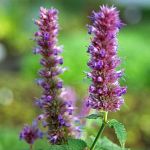| Common Name: |
Korean Mint |
| Other Names: |
Wrinkled giant hyssop |
| Botanical Name: |
Agastache rugosa syn. Lophanthus rugosus |
| Genus: |
Agastache |
| Family: |
Lamiaceae |
| Native Location: |
E Asia |
| Cultivation: |
Well drained soil in sun. Agastache foeniculum tolerates poorer soils and drier conditions than A. rugosa. Leaves may be affected by powdery mildew in dry conditions. |
| Propagation: |
By seed sown in spring at 13-18°C (55-64°F); by division in spring; by semi-ripe cutting in summer. |
| Harvest: |
Leaves (A. foeniculum, A. rugosa) are collected in spring and summer, and flowers in summer, for use fresh or dried as a flavoring for teas. Leaves and stems (A. rugosa) are cut before flowering and dried for medicinal use. |
| Height: |
1-1.2m (3-4ft) |
| :Width |
60cm (24in) |
| Hardiness: |
Z7-10 |
| Parts Used: |
Leaves, stems (aerial parts are known as huo xiang) |
| Properties: |
An aromatic, anti-bacterial herb that stimulates the digestive system, relaxes spasms, and also helps to lower fever by increasing perspiration. |
| Medicinal Uses: |
Internally, in traditional Chinese medicine, to improve appetite and to relieve dyspepsia, nausea, and vomiting; also for the common cold when characterized by chills. Unsuitable for feverish colds. Interchangeable with Pogostemon cablin (see patchouli). |
| Culinary Uses: |
Fresh or dried leaves provide flavoring for meat dishes and salads, and make a pleasant tea. |
| Bibliography: |
Encylopedia of Herbs by Deni Brown Copyright ©: 1995, 2001 Dorling Kindersley Limited pp 105-106
|

